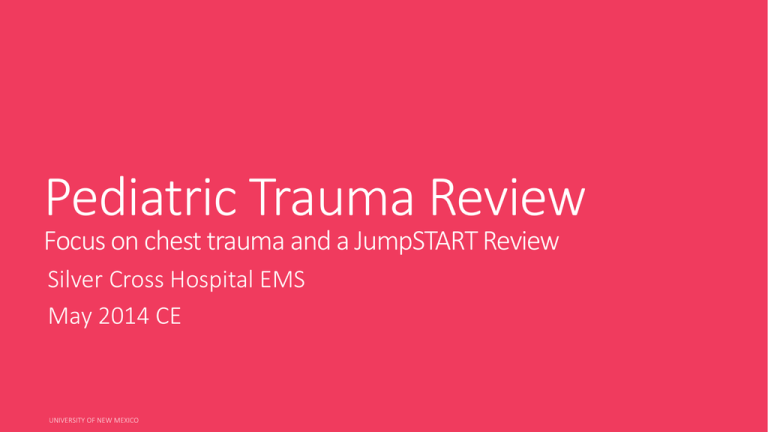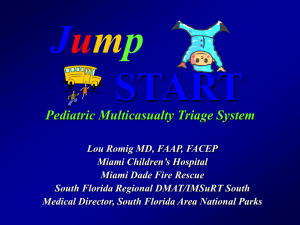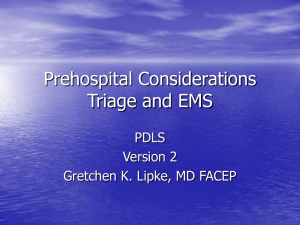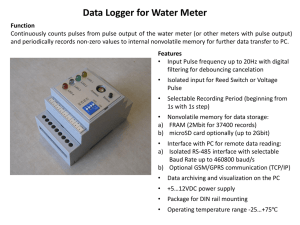Pediatric Trauma - Silver Cross Emergency Medical Services System
advertisement

Pediatric Trauma Review Focus on chest trauma and a JumpSTART Review Silver Cross Hospital EMS May 2014 CE Epidemiology - General Trauma is the leading cause of death between the ages of 1-18 Injury accounts for 5% of infant deaths 47% of these deaths are related to MVCs With rates higher in those >13yo 13% of deaths in those 1-14yo were a result of homicide In the school age group Pedestrian injuries and bike injuries predominate Pediatric Head Injury #1 cause of death due to trauma ~2700 deaths/year 450,000 children present to EDs each year with head injury 90% suffer from minor injuries Perinatal period Birth injuries 1-4 years old Falls School age Pedestrian or bike injuries Adolescence MVA Children have larger heads than adults in relation to their body The chance that it is hit in a traumatic event is larger Head is heavy Different acceleration dynamics At birth, face to cranium ratio is 1:8, adult ratio is 1:2.5 Makes it more likely skull is hit in younger children Lack of pneumatization of sinuses is associated with more rigidity and less plasticity of facial skeleton Increases transfer of forces directly to brain Pediatric Spine Injury 18.1 spinal cord injuries per million children 1300 new cases a year 60-80% of injuries occur at the cervical level Adults have a 30-40% incidence Children <8 yo More likely to sustain high cervical (C1C3) injuries Pediatric Thoracic Trauma #2 cause of trauma related mortality In isolation, thoracic trauma carries a 5% mortality 25% when combined with abdominal injury 40% with head and abdominal injury Anatomic Considerations Incomplete ossification of ribs allows anterior ribs to be compressed to meet posterior Pulmonary contusions are common, rib fractures uncommon Pulmonary contusions are most common thoracic injury in traumatized children Trachea is narrow, short, more compressible Great vessel and cardiac injury are rare in children Anatomic Considerations Commotio Cordis is a unique consequence of pediatric thoracic trauma Abrupt strike to the chest leads to V-Fib and arrest Pericardial tamponade: Pericardial tamponade is caused by blunt or penetrating trauma to the heart. Blood leaks into the pericardial sac, causing compression of the heart. As the volume of blood in sac increases, the compression of the heart becomes more pronounced. This causes cardiac output to fall dramatically and leads to a backup of volume in the venous system. Pericardial Tamponade Signs of pericardial tamponade are: Broken ribs or penetrations to chest wall. Dyspnea/Cyanosis Neck vein distention Weak, thready pulse Decreasing blood pressure Shock Narrowing pulse pressure Pericardial Tamponade Treatment: Oxygenation Assisted ventilation as necessary IV therapy EKG monitoring Rapid transport to nearest I Trauma facility Cardiac Contusion: Cardiac contusion is a common injury following severe blunt trauma to the chest. It usually occurs when the heart is compressed between the sternum and the spinal column. Severe contusions may include rupture of the heart wall. Most commonly, the right ventricle is injured, as it lays directly beneath the sternum. Cardiac contusion Signs of cardiac contusion are: Bruising, swelling, crepitus or deformity to chest wall Tachycardia Irregular heart rhythm Cardiac Contusion Treatment: Oxygenation Assisted ventilation as necessary IV therapy EKG monitoring Treatment of arrhythmias as necessary Transport to nearest appropriate trauma facility Commotio Cordis: Commotio cordis, or “concussion” of the heart, is generally described as “instantaneous cardiac arrest produced by nonpenetrating chest blows in the absence of heart disease or identifiable morphologic injury to the chest wall or heart.” Commotio Cordis represents one of the most common mechanisms of sudden death in sports seen in young athletes. Commotio Cordis— Review of Condition Classic presentation is a blow to the chest during a sporting activity that precipitates sudden collapse, followed by death if prompt resuscitation is not available. Most commonly occurs during baseball, but can occur during hockey, lacrosse, karate, and recreational activities such as sledding or biking. Case Study You are called to a baseball game for a child hit with a baseball that is now unresponsive. Bystanders initiated CPR. Case Study CPR is initiated and the Cardiac monitor is applied. •Initial rhythm is: 1.What rhythm do you see? 2.What is your treatment priority? Case Study After delivering 3 shocks, the patient remains unresponsive, pulseless, and apneic with the rhythm shown below. What is your next intervention? Case Study The patient has been intubated with a 6.0 ETT, and is being ventilated with high FiO2 via BVM. An IV of NS is initiated. — What is your next intervention? Case Study Epinephrine 1:10,000 is determined to be the next intervention. Continuation of CPR and PALS/SMO protocol Case Study Journal of the American Medical Association, 2002;287:1142-1146 In a study of 128 confirmed cases of commotio cordis, a 15% survival rate was reported when resuscitative measures were initiated within 3 minutes of the event. In cases where resuscitation was delayed, >3 minutes, the survival rate was noted to be <1%. Pediatric Abdominal Trauma Third leading cause of pediatric traumatic death Blunt causes in 85%, penetrating trauma in 15% Blunt trauma related to MVC’s causes more than 50% of abdominal injuries in children Boogie board related injury..! Anatomic Considerations Proportionally larger solid organs Less subcutaneous fat Less protective abdominal musculature Relatively larger kidneys that predispose them to renal injury Anatomic Considerations Splenic injuries are the largest proportion of pediatric abdominal trauma Liver is second most injured solid organ Lap Belt Injury Sudden increase in bowel intraluminal pressure can result in intestinal perforation Chance fracture of the lumbar spine Anatomic Considerations The compliant chest wall, poor thoracic musculature and weak diaphragm can lead to considerable respiratory difficulty with gastric distention Epinephrine Generic Name: Epinephrine Trade Name: Adrenalin® Therapeutic Class: Sympathomimetic Mechanism of Action: —Alpha: Bronchial, cutaneous, renal & visceral arterial constriction. —Beta 1: Positive inotropic & chronotropic actions, increase in cardiac automaticity. —Beta 2: Bronchial smooth muscle relaxation and dilation of skeletal vasculature, blockage of histamine release. Epinephrine Pharmacokinetics: Onset with IV injection is immediate and intensified. SC or IM injection gives a rapid onset with longer duration. Half-life is 1-4 minutes. Prehospital Indications: Cardiac arrest Bradycardia with profound hypotension Severe bronchospasm Anaphylaxis Contraindications: Hypertension Narrow angle glaucoma Pulmonary edema JumpSTART review The following is a PowerPoint from Dr. Lou Romig. She developed jumpstart as a tool for evaluation and triaging pediatric MCI. JumpSTART Review Please note that JumpSTART was designed for use in disaster/multicasualty settings, not for daily EMS or hospital triage. Jump START Pediatric Multicasualty Triage System Lou Romig MD, FAAP, FACEP Miami Children’s Hospital Miami Dade Fire Rescue South Florida Regional DMAT/IMSuRT South Medical Director, South Florida Area National Parks Earthquake, Algeria Earthquake, Iran Earthquake, Italy Tsunami, Indonesia Building collapse, Jerusalem Tornado, Kansas Bus crash, Michigan Beslan school siege Moscow theater siege OKC Bombing We must assume each MCI will include children. We must be able to assess and treat victims of all ages with equal confidence and competence. What’s your call? Photos by Bryan Patrick, The Sacramento Bee, 2000 What’s your call? A bus carrying school children of various ages and their chaperones on a field trip loses control, slams into a median, then rolls. You are the triage officer. What’s your call? A young school aged boy is found lying on the roadway 10 ft from the bus. Breathing 10/min Good distal pulse Groans to painful stimuli What’s your call? An adult kneels at the side of the road, shaking his head. He says he’s too dizzy to walk. RR 20 CR 2 sec Obeys commands What’s your call? A school aged girl crawls out of the wreckage. She’s able to stand and walk toward you crying. Jacket and shirt torn No obvious bleeding What’s your call? A toddler lies with his lower body trapped under a seat inside the bus. Apneic Remains apneic with modified jaw thrust No pulse What’s your call? Adult female driver still in the bus, trapped by her lower legs under caved-in dash. RR 24 Cap refill 4 sec Moans with verbal stimulus What’s your call? A toddler lies among the wreckage. RR 50 Palpable distal pulse Withdraws from painful stimulus What’s your call? A woman is carrying a crying infant. She is able to walk. RR 20 CR 2 sec Obeys commands What’s your call? An infant is carried by the previous victim. He’s screaming but the woman quiets him to RR of 34 Good distal pulse Focuses on rescuer, reaches for mom. No obvious significant external injuries. What’s your call? A young school aged boy props himself up on the road. RR 28 Good distal pulse Answers question and commands. Has obvious deformity of both lower legs. What’s your call? A toddler is found outside the bus, lying on the ground in a heap. Apneic Remains apneic with jaw thrust Faint distal pulse palpable What’s your call? A school aged girl lies among the wreckage. RR 40 Absent distal pulse Withdraws from painful stimulus What’s your call? A screaming infant is found among the bushes at the side of the road. RR 38 Good distal pulse Focuses and reaches for you. Has a partial amputation of the foot without active bleeding. What’s your call? An adult male lies inside the bus. Apneic Remains apneic with jaw thrust What’s your call? A youngster is up and walking around but is limping Alert, crying hysterically for his mother What’s your call? A school aged boy lies close to the bus. RR 36 Absent distal pulse Sluggishly looks at you when you talk to him What’s your call? A young teen girl lies among the wreckage, crying for someone to help her up. A man with her says she needs her wheelchair. RR 22 Palpable distal pulse Alert Has minor cuts and bruises What’s your call? An adult male lies on the ground RR 20 Good distal pulse Obeys commands but cries that he can’t move his legs What’s your call? An older school aged child is found sitting outside the bus. RR 28 Good distal pulse Groggy, confused and slowly follows commands but won’t get up and walk. Goal of Multicasualty Triage “To do the best for the most using the least.” Primary Disaster Triage Goal: to sort patients based on probable needs for immediate care. Also to recognize futility. Assumptions: Medical needs outstrip immediately available resources Additional resources will become available with time Primary Disaster Triage Triage based on physiology How well the patient is able to utilize their own resources to deal with their injuries Which conditions will benefit the most from the expenditure of limited resources The physiology of adults and children are not the same. Why do we need a pediatric tool? To optimize triage effectiveness to the benefit of all victims, not just children. Photo by Bryan Patrick, The Sacramento Bee, 2000 Why do we need an objective pediatric tool? The pediatric knowledge base and confidence levels of many EMS providers are not as good as they can and should be. Pediatric multicasualty triage may be affected by the emotional state of triage officers. Ambulatory = Green START Triage RESPIRATIONS NO Dead or Expectant PERFUSION Over 30/min Position Airway NO Under 30/min YES Immediate YES Immediate Cap refill > 2 sec Control Bleeding Immediate Cap refill < 2 sec. MENTAL STATUS Failure to follow simple commands Can follow simple commands Immediate Delayed START: Potential Problems with Children An apneic child is more likely to have a primary respiratory problem than an adult. Perfusion may be maintained for a short time and the child may be salvageable. RR +/- 30 may either over-triage or under-triage a child, depending on age . START: Potential Problems with Children Capillary refill may not adequately reflect peripheral hemodynamic status in a cool environment. Obeying commands may not be an appropriate gauge of mental status for younger children. JumpSTART Goals Modify an existing tool for use with children Utilize decision points that are flexible enough to serve children of all ages and reflective of the unique points of pediatric physiology Minimize over- and under-triage Accomplish triage within 30 second/pt goal JumpSTART: Age Initially ages 1-8 years chosen Less than one year of age is less likely to be ambulatory. The pertinent pediatric physiology (specifically, the airway) approaches that of adults by approximately eight years of age. I’m 10! JumpSTART: Age Current recommendation: If a victim appears to be a child, use JumpSTART. If a victim appears to be a young adult, use START. JumpSTART: Ambulatory Identify and direct all ambulatory patients to designated Green area for secondary triage and treatment. Begin assessment of nonambulatory patients as you come to them. Modification for nonambulatory children All children carried to the GREEN area by other ambulatory victims must be the first assessed by medical personnel in that area. JumpSTART: Breathing? If breathing spontaneously, go on to the next step, assessing respiratory rate. If apneic or with very irregular breathing, open the airway using standard positioning techniques. If positioning results in resumption of spontaneous respirations, tag the patient immediate and move on. The “Jumpstart” Part If no breathing after airway opening, check for peripheral pulse. If no pulse, tag patient deceased/nonsalvageable and move on. If there is a peripheral pulse, give 5 mouth to barrier ventilations. If apnea persists, tag patient deceased/nonsalvageable and move on. If breathing resumes after the “jumpstart”, tag patient immediate and move on. JumpSTART: Respiratory Rate If respiratory rate is 15-45/min, proceed to assess perfusion. If respiratory rate is <15 or >45/min or irregular, tag patient as immediate and move on. JumpSTART:Perfusion If peripheral pulse is palpable, proceed to assess mental status. If no peripheral pulse is present (in the least injured limb), tag patient immediate and move on. JumpSTART: Mental Status Use AVPU scale to assess mental status. If Alert, responsive to Verbal, or appropriately responsive to Pain, tag as delayed and move on. If inappropriately responsive to Pain or Unresponsive, tag as immediate and move on. Modification for nonambulatory children Infants who normally can’t walk yet Children with developmental delay Children with acute injuries preventing them from walking before the incident Children with chronic disabilities Modification for nonambulatory children Evaluate using the JS algorithm If any RED criteria, tag as RED. If pt satisfies YELLOW criteria: YELLOW if significant external signs of injury are found (ie. deep penetrating wounds, severe bleeding, severe burns, amputations, distended tender abdomen) GREEN if no significant external injury Individuals with special health care needs may also be MCI victims! Note for Black Category Victims Unless clearly suffering from injuries incompatible with life, victims tagged in the BLACK category should be reassessed once critical interventions have been completed for RED and YELLOW patients. Putting it into practice What’s your call? A young school aged boy is found lying on the roadway 10 ft from the bus. Breathing 10/min Good distal pulse Groans to painful stimuli What’s your call? An adult kneels at the side of the road, shaking his head. He says he’s too dizzy to walk. RR 20 CR 2 sec Obeys commands What’s your call? A school aged girl crawls out of the wreckage. She’s able to stand and walk toward you crying. Jacket and shirt torn No obvious bleeding What’s your call? A toddler lies with his lower body trapped under a seat inside the bus. Apneic Remains apneic with modified jaw thrust No pulse What’s your call? Adult female driver still in the bus, trapped by her lower legs under caved-in dash. RR 24 Cap refill 4 sec Moans with verbal stimulus What’s your call? A toddler lies among the wreckage. RR 50 Palpable distal pulse Withdraws from painful stimulus What’s your call? A woman is carrying a crying infant. She is able to walk. RR 20 CR 2 sec Obeys commands What’s your call? An infant is carried by the previous victim. He’s screaming but the woman quiets him to RR of 34 Good distal pulse Focuses on rescuer, reaches for mom. No obvious significant external injuries. What’s your call? A young school aged boy props himself up on the road. RR 28 Good distal pulse Answers question and commands. Has obvious deformity of both lower legs. What’s your call? Toddler found outside the bus, lying on the ground in a heap. Apneic Remains apneic with jaw thrust Faint distal pulse palpable. OR What’s your call? A school aged girl lies among the wreckage. RR 40 Absent distal pulse Withdraws from painful stimulus What’sA screaming your infant call? is found among the bushes at the side of the road. RR 38 Good distal pulse Focuses and reaches for you. Has a partial amputation of the foot without active bleeding. What’s your call? An adult male lies inside the bus. Apneic Remains apneic with jaw thrust What’s your call? A youngster is up and walking around but is limping Alert, crying hysterically for his mother What’s your call? A school aged boy lies close to the bus. RR 36 Absent distal pulse Sluggishly looks at you when you talk to him What’s your call? A young teen girl lies among the wreckage, crying for someone to help her up. A man with her says she needs her wheelchair. RR 22 Palpable distal pulse Alert Has minor cuts and bruises What’s your call? An adult male lies on the ground RR 20 Good distal pulse Obeys commands but cries that he can’t move his legs OR What’s your call? An older school aged child is found sitting outside the bus. RR 28 Good distal pulse Groggy, confused and slowly follows commands but won’t get up and walk. JumpSTART’s reception In use throughout the US and Canada Being taught in Germany, Switzerland, Japan, Polynesia and other countries Included in the NDMS Core Curriculum Incorporated into the PDLS and APLS courses Feature article, July 2002 JEMS magazine Included in Brady’s Prehospital Emergency Care, 7th ed Publication in other texts pending Advantages JumpSTART provides a rapid triage system specifically designed for children, taking into consideration their unique physiology. The algorithm is modified from an existing system widely accepted for adult triage. For most patients, triage can be accomplished within the 30 second goal. Advantages Objective triage criteria for children will help to eliminate the role of emotions in the triage process. Objective triage criteria will provide emotional support for triage personnel forced to make life or death decisions for children in the MCI setting. For more information on JumpSTART: www.jumpstarttriage.com Lou Romig MD LouRomig@bellsouth.net Thank you for your time and attention! If you have any questions, please contact Silver Cross EMS Education at 815-300-2909









